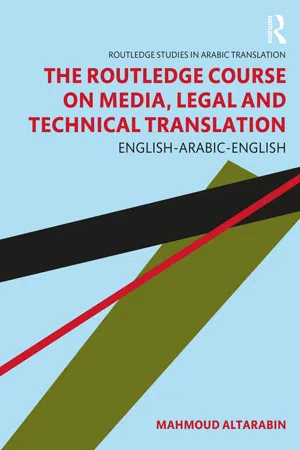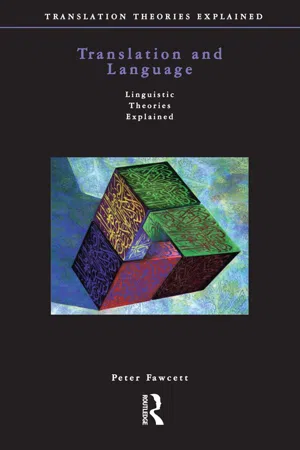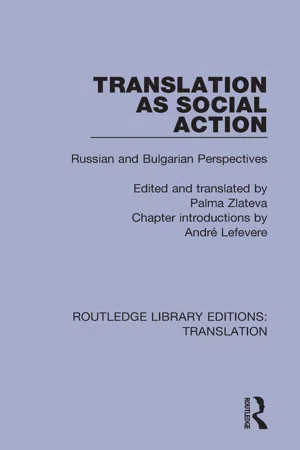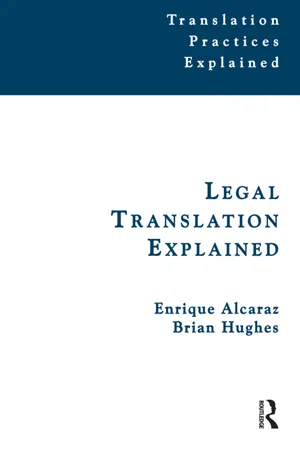False Equivalence
False equivalence is a logical fallacy that occurs when two opposing arguments are presented as being equally valid, even though one is significantly stronger than the other. In linguistics, false equivalence can arise when comparing different languages or dialects, leading to inaccurate or unfair assessments of their respective qualities or complexities.
4 Key excerpts on "False Equivalence"
- eBook - ePub
The Routledge Course on Media, Legal and Technical Translation
English-Arabic-English
- Mahmoud Altarabin(Author)
- 2020(Publication Date)
- Routledge(Publisher)
...Nida (1964) introduced formal equivalence focusing on SL message form and content and dynamic equivalence aiming at an “equivalent effect.” Practically, formal equivalence between Arabic and English does not pose a challenge unlike the dynamic equivalence because the chances of achieving the latter heavily rely on paralinguistic factors. This is reflected in Catford’s (1965) argument that TL translation equivalents are a central problem of translation activity. Newmark (1981) argues that translation equivalence is useless and that “perfect translation is illusionary” (1991). Biguenet and Schulte (1989) and Baker (2018) stress the impossibility of achieving exact equivalence between any language pair. Baker (2018), Koller (1995), Ivir (1996), House (1997), Snell-Hornby (1988), Bassnett (2002), Hatim and Munday (2004), and Fawcett (1997) maintain that linguistic and cultural factors make equivalence relative. Venuti (1995) believes that translation causes violent effects at home and abroad. He highlights the massive power of translation in constructing national identities for foreign cultures and points out that translation potentially figures in ethnic discrimination, geopolitical confrontations, colonialism, terrorism, and war. On the intralingual level, finding two words bearing the same meaning in all contexts is “a luxury a language can do without” (Jackson, 1988, p. 65). Although a language can express certain meanings using a limited number of words, another may express the same with a larger number (Biguenet & Schulte, 1989), which points to non-equivalence at the linguistic level. Broeck (1978) explains that a strict equivalence relationship does not apply to translation. Lack of equivalence can be attributed to lexical, syntactic, or pragmatic differences between different languages that makes it difficult to provide perfect guidelines to deal with various types of non-equivalence (Baker, 2018)...
- eBook - ePub
- Peter Fawcett(Author)
- 2014(Publication Date)
- Routledge(Publisher)
...been. Snell-Hornby (1988 :22) takes the view that “equivalence is unsuitable as a basic concept in translation theory” because it is “imprecise and ill-defined (even after a heated debate of over twenty years)”. The stakes in relation to the concept of equivalence are high. When Kelly (1979 :24) asks “What does the linguist have to offer the translator?”, his answer is “The most obvious is analysis of equivalence, and some objective justification of the translator’s intuitions”. There have been many definitions of equivalence, and it would be tedious to go through them all here. The most famous are probably those of Catford and Nida. Catford and textual equivalence Catford deserves a mention, even though Snell-Hornby (1988:14–15) believes his approach “is now generally considered dated and of mere historical interest”. He describes equivalence as a ‘key term’ and tells us that “The central problem of translation practice is that of finding TL |target-language] translation equivalents. A central problem of translation theory is that of defining the nature and conditions of translation equivalence” (1965:21). Catford makes a distinction between formal correspondence and what he calls ‘textual equivalence’ (1965:27), but this is not necessarily a distinction between two approaches to translation. Formal correspondence is a matter of langue whereas textual equivalence is a matter of parole. Formal correspondence exists where a target-language category occupies the same position in its language system as the same or some other category in the source language. Thus prepositions seem to operate in the same way in most European languages (1965:32–33). In so far as we can translate preposition by preposition in these languages, formal correspondence gives us textual equivalence...
- eBook - ePub
Translation as Social Action
Russian and Bulgarian Perspectives
- Palma Zlateva(Author)
- 2018(Publication Date)
- Routledge(Publisher)
...But are translators therefore justified in recreating this reality in a way that differs from that in which it is depicted in the original? Such an approach would vitiate the very essence of translation and substitute the translator’s own vision of reality for the author’s. The distinction between linguistic and non-linguistic factors is accepted in thinking on translation. Nonetheless, it remains some what oversimplified, since much of what resorts under the second category is suggested both by the translated text and by the experience of the qualified translator. Even a given translator’s degree of competence in a given field referred to in the original must be counted among the factors defining the functional basis for regular correspondence. EQUIVALENT CORRESPONDENCES The notion of “equivalent” in thinking about translation is twofold. “Equivalent” often means every correspondence to a word or combination of words in the original in a given concrete context or, in other words, every properly established correspondence to a macro-unit of translation. Such a non-constructive understanding of equivalence, however, nullifies any significant difference between categories of dictionary equivalents. Rather, “equivalent” should be taken to mean a constant, regular, context-free correspondence. Equivalents are something like catalysts in the process of translation. It is hard to overestimate the part they play, particularly in the process of interpretation...
- eBook - ePub
- Enrique Alcaraz, Brian Hughes, Anthony Pym, Anthony Pym(Authors)
- 2014(Publication Date)
- Routledge(Publisher)
...2. Equivalence and Interpretation 1. The question of equivalence in Translation Studies Translation Studies has set itself the task of building models aimed at explaining what goes on during the process of translation. A very basic model of this process was suggested in Chapter 1 above. Put at its most embarrassingly simple, this consists of the following three stages: 1) A thorough understanding of the ideas of the source text and the means by which these ideas have been achieved and expressed; 2) The attempt to express these ideas in linguistically equivalent terms in the target language; 3) The proviso that, other things being equal, the criterion of ‘naturalness’ of target-language expression is to preside over any other in attaining the equivalence referred to in stage (2), ‘naturalness’ being understood to mean the avoidance of strain or the forcing of sense or syntax. We are aware that this may sound simplistic amid the sophistications of current theories of translation, and that questions of equivalence are especially problematic in the field of legal translation. For obvious reasons, the conceptual analysis of equivalence (Rabadán 1991) has tended to vary with the theories prevalent, or fashionable, at different stages of linguistic studies. Thus, for Nida (1975), semantic equivalence is an essential prerequisite for effective translation. More recently, linguistic pragmatics has added new variables to the study of the phenomenon of equivalence, notably the idea of contextualized meaning (Alcaraz 1996:104). For this school, semantics (and hence syntactic choices) includes what is implied, assumed or tacitly understood by those involved in the context of utterance. For our purposes, this is clearly helpful in the translation of oral genres like the examination of witnesses and is relevant to our understanding of the sensitive issue of ‘leading questions’ during this process...



